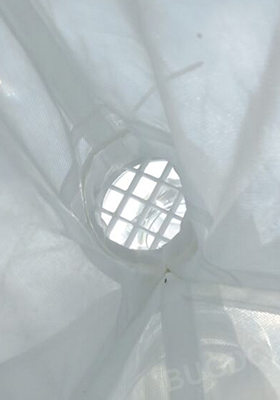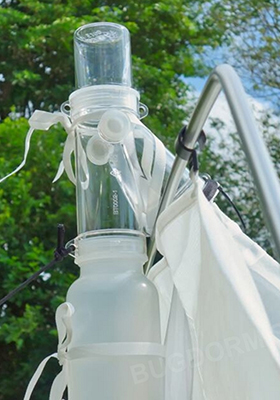Modular, field-ready Malaise trap for efficient insect sampling
The Townes-style ez-Malaise trap is a modular, stand-alone flight-intercept device for passive insect sampling. Operating without bait, it enables standardized surveys of aerial arthropods and is suited to both short-term relocatable studies and long-term ecological monitoring. Shock-corded poles and clip-on fittings allow rapid deployment at sites lacking natural supports. The design is patented.
¤ōØField Story: In VietNam, a researcher told us she nearly cried with relief the first time she set up the ez-Malaise trap. Previously, she had to cut and carry heavy bamboo poles for traditional traps. The modular frame removed this burden, making insect trapping truly “easy.”
Detailed Description
Malaise traps intercept flying insects with a vertical panel; intercepted insects move upward toward light and are guided into a collection bottle. As an unbaited method, catch rates depend on trap placement, so ease of setup is essential for standardized designs.
The ez-Malaise trap preserves the proven Townes-style geometry while introducing modularity for field practicality. Components such as the collection head, fabric body, tall-end pole, and short-end pole can be replaced individually, reducing downtime and extending service life.
The inverted Y-shaped collection head is molded from solid polycarbonate (PC) for durability, UV resistance, and high transparency. Ventilation ports, closed by default, allow optional airflow, and some studies report increased catch efficiency when airflow is enhanced. A removable moth excluder with 1 × 1 cm grid spacing limits entry of larger insects (e.g., Lepidoptera) and helps reduce wing-scale contamination. Seat the head on the supporting pole rather than the fabric body to ensure proper alignment.
Removable Moth Excluder
 Removable Moth Excluder
Removable Moth Excluder
Collection Head Placement
 Collection Head Placement
Collection Head Placement
Functional Advantages
- Townes-style, single-headed intercept: Baseline biodiversity sampling without bait; directs insects upward into the collection bottle.
- Rapid setup: Shock-corded poles and clip-on assembly enable quick deployment without external supports; requires at least two guy ropes for stability.
- Modular build: Replaceable parts minimize downtime and extend service life.
- Collection head: Durable polycarbonate featuring optional airflow vents and a removable moth excluder to minimize contamination.
- Flexible mounting: Use on its freestanding pole frame or suspend from natural supports via built-in loops.
Authenticity: BugDorm traps are original, field-proven designs referenced in hundreds of published studies worldwide. Copies may exist, but only BugDorm traps are manufactured to strict specifications that ensure mesh uniformity and material consistency for reliable data comparability across projects.
Field Notes
- Placement: Place along trails, forest edges, or stream corridors; orient the intercept panel perpendicular to expected insect flight paths and keep approaches clear.
- Collection head: Seat the head on the supporting pole, not the fabric. Keep upright, tie securely, and recheck seating after line re-tensioning or whenever the collection bottle is serviced.
- Ventilation ports: Open ports of the collection head can improve airflow but may also admit rainwater, causing preservative dilution. They can likewise accelerate evaporation.
- Preservative and labels: Use ethanol or propylene glycol as appropriate. Label bottles with trap ID, date/time, and preservative used.
- Hot or dry sites: Provide modest shade to reduce preservative evaporation and top up to prevent desiccation.
- Servicing: Empty or replace bottles on a regular schedule (e.g., weekly), adjusting for catch volume and weather. Re-tension guy ropes to maintain panel shape.
- Multiple traps: Space units 50–150 m apart to reduce spatial dependence. Record trap-days and relevant covariates (weather, vegetation structure, edge distance).
- Orientation and canopy studies: For flight-direction tests, use the dual-headed ez-Migration trap. For canopy or multi-layer sampling, use the freestanding SLAM trap, which can be suspended or daisy-chained.
Ōä╣’ĖÄDisclaimer: Field Notes provide practical guidance and examples. Actual procedures should be adapted to site conditions, study objectives, and institutional protocols. Users are responsible for safe deployment and compliance with local regulations.
Pack Contents
- 1 × Fabric Trap Body
- 1 × Shock-corded Pole (L309 cm)
- 1 × Shock-corded Pole (L459 cm)
- 1 × Collection Head (pre-installed)
- 3 × Collection Bottles (1 pre-installed)
alternative option
Nalgene™ 2105-0016 wide-mouth bottles (53 mm closure size; unavailable from this site) are compatible with the supplied bottles.
- 9 × Guy Ropes
- 9 × Plastic X-Stakes
- 8 × Alloy Pin Stakes
- 1 × Carrying Bag
Prepare extra guy ropes and stakes as needed. Additional replacement parts are listed under the Parts tab.
Recent Literature Related to This Product Line (click to search more)
- The Hemiptera (Insecta) of Canada: Constructing a Reference Library of DNA Barcodes. Gwiazdowski et al. (2015). PLoS One, 10(4), e0125635.
- DNA barcoding in diverse educational settings: five case studies. Henter et al. (2016). Phil. Trans. R. Soc. B, 371(1702), 20150340.
- The School Malaise Trap Program: coupling educational outreach with scientific discovery. Steinke et al. (2017). PLoS Biology, 15(4), e2001829.
- Arthropods in modern resins reveal if amber accurately recorded forest arthropod communities. Solórzano Kraemer et al. (2018). PNAS, 115(26), 6739–6744.
- Expedited assessment of terrestrial arthropod diversity by coupling Malaise traps with DNA barcoding. deWaard et al. (2019). Genome, 62(3), 85–95.
- Using DNA-barcoded Malaise trap samples to measure impact of a geothermal energy project on the biodiversity of a Costa Rican old-growth rain forest. Janzen et al. (2020). Genome, 63(9), 407–436.
- A Review of Terrestrial and Canopy Malaise Traps. Michael et al. (2021). Ann. Entomol. Soc. Am., 114(1), 27–47.
- Peering into the Darkness: DNA Barcoding Reveals Surprisingly High Diversity of Unknown Species of Diptera (Insecta) in Germany. Chimeno et al. (2022). Insects, 13(1), 82.
- Optimizing insect metabarcoding using replicated mock communities. Iwaszkiewicz-Eggebrecht et al. (2023). Methods in Ecology and Evolution, 14(4), 1130–1146.
- Global arthropod beta-diversity is spatially and temporally structured by latitude. Seymour et al. (2024). Communications Biology, 7(1), 552.